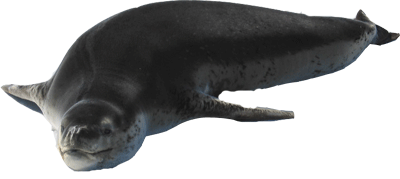Lepard Seal

Scientific Classification
Kingdom: Animalia
Phylum: Chordata
Class: Mammalia
Order: Carnivora
Suborder:Pinnipedia
Family: Phocidae
Genus: Hydrurga
Species: H. leptonyx
Description
Leopard Seals (Hydrurga leptonyx) are lonely animals that inhabit pack-ice nearby the Antarctic continent. The leopard seal is easily identified: designed for speed, the body is slender and the foreflippers long. The head is huge and the jaws open extensively revealing exceptionally long canines and unusually complex sharply pointed molars. Like the crabeater seals, leopard seals have strange teeth for straining krill. Males (2.8 m; 320 kg) are usually slightly smaller than females (3.0 m; 370 kg). Large females may reach lengths in excess of 3.5 m and weigh over 500 kg. Leopard seals may live for 26 years or more.
Diet
Leopard seals eat almost anything. Their favourite food would be penguins but seals, fish, squid and crustaceans are also consumed. Seals eaten include seal pups of crabeater, Weddell and fur seals. One animal, captured near Sydney, contained a full grown platypus.
The feeding behaviour of leopard seals is simply seen when their prey is penguin. Naturally the seals chase or grab penguins in the water and thrash the captured bird back and forth until the skin peels away. The remaining carcass is then consumed.
Leopard seals have very individual tastes. Some stay near penguin colonies and eat the penguins they grasp there while others favor to eat crabeater seal pups. Other leopard seals wish a subantarctic menu and migrate north to Heard Island to feed on penguin and seal pups there.
Breeding
Because leopard seals are solitary animals that live in the vasts of the Antarctic pack ice, little is known of their biology. Female leopard seals of six years or more provide birth to a single pup on the sea-ice in November behind a nine month gestation, and then return to the ocean to feed. The pup may weigh in excess of 30kg.
Abundance and Distribution
Leopard seals are perhaps the most wanderers of the Antarctic seals with sightings in Tasmania and a most northern record at Heron Island. Heron Island is situated at 23 degrees 27 minutes South - quite some distance from the Antarctic! Taronga Park Zoo has a captive animal
 Deep Sea Crabs
Deep Sea Crabs